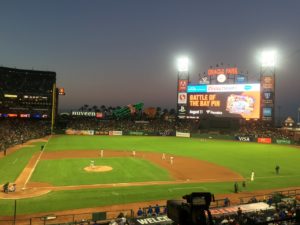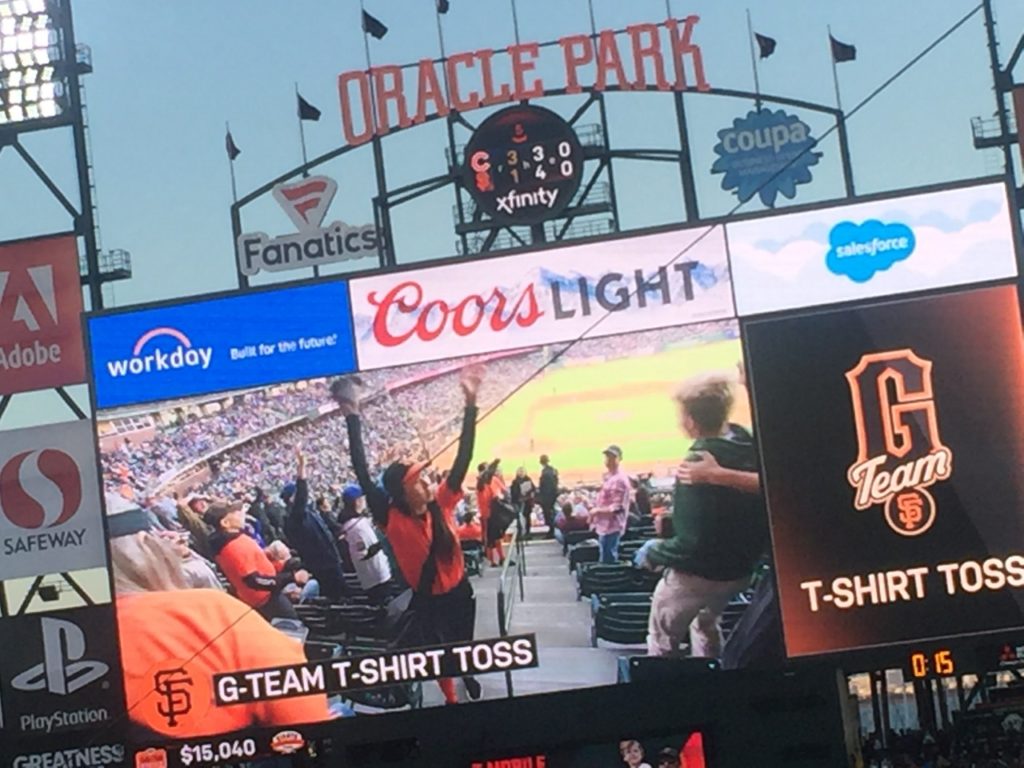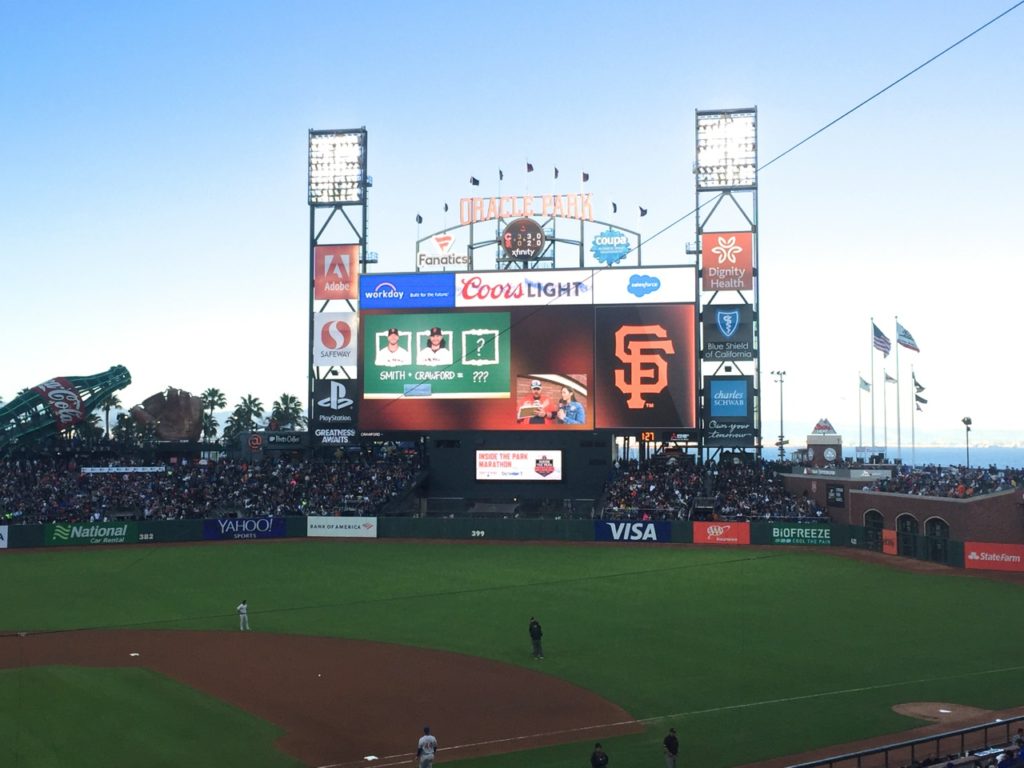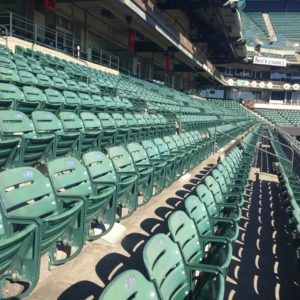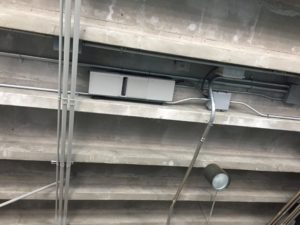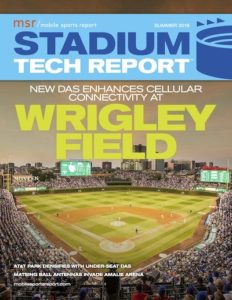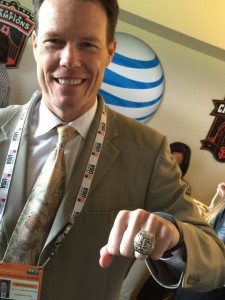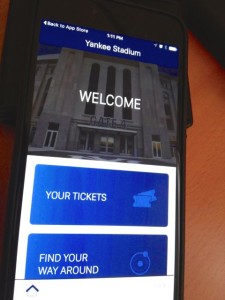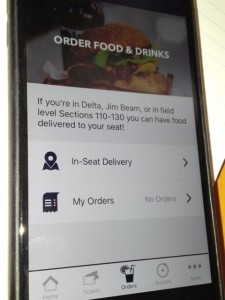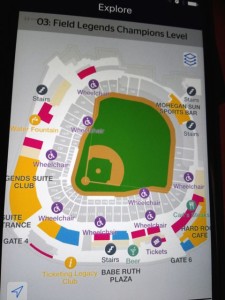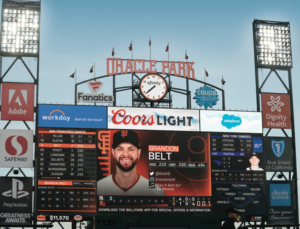
The new video board at Oracle Park, which stretches from light tower to light tower. Credit: San Francisco Giants (click on any picture for a larger image)
The San Francisco Giants certainly think so, as the team replaced its main outfield display this season with a new screen that is three and a half times bigger, and a lot sharper than the previous technology.
Though he said it wasn’t a slam-dunk decision internally, Giants senior vice president and chief information officer Bill Schlough said the team eventually went with as big a screen as the park’s existing infrastructure allowed, with improving the fan experience as the main driver.
What fans at the newly renamed Oracle Park are looking at this season is a 71-foot high, 153-foot wide LED board from Mitsubishi, with a 10-mm pixel pitch and resolution of 2,160 x 4,672, dense enough to support 4K content when it becomes available. The new board stretches to fill the space between two light towers in centerfield, replacing a previous arrangement of a smaller board surrounded by a batch of static display signs, an arrangement that was part of the internal controversy, according to Schlough.
Is digital always better?
Editor’s note: This profile is from our most recent issue of our VENUE DISPLAY REPORT series, where we focus on telling the stories of successful venue display technology deployments and the business opportunities these deployments enable. This issue also contains profiles of the innovative directory displays at the Mall of America, and an in-depth look at display technology at U.S. Bank Stadium during the Final Four! START READING the issue today!
“It was an incredibly controversial topic inside the organization,” said Schlough of the debate about how big the Giants’ new screen should be. Though conventional wisdom says that digital signage can produce greater revenue than fixed signage due to its ability to change on demand, Schlough said that some salespeople and sponsors still like the permanence of a fixed display.
“When you are selling sponsorships there are pros and cons for each method,” Schlough said. “With digital you can have moments of exclusivity, where one sponsor can take over all the signage, and you can animate to capture the attention of fans.”But the cons of digital signs include the fact that they can be turned off, a fact that may make a signage sponsor less willing to commit if it knows its message may be blanked out — as opposed to a static sign, which can’t be changed. According to Schlough the debate about the size of the new board was one of the most contentious technology decisions he’s seen during his 20-year career at the Giants, with only the team’s then-controversial decision to put Wi-Fi APs under seats (in 2013) coming close.
In the end the bigger-is-better side won out, in what Schlough said is part a nod to everyday experience with TVs as well as a hedge against the fact that stadium video screens often stay in place for many years.
“When’s the last time you came home with a TV from Best Buy and said, ‘it’s too big’ ?” Schlough joked.
On the more serious side, he did note that the Giants’ previous screen had lasted for 12 years — going from being just the third high-definition screen in all of Major League Baseball when it was installed to being the fifth-smallest and second-oldest in MLB by last season.
“You don’t get that many bites at the apple, and if you’re only making this kind of an investment every 10 years, there’s no way you can go too big,” Schlough said. The new board is now the third-largest in MLB, behind only Cleveland and Seattle. The team did seem to compromise for the fixed-sign contingent, adding more static display spots mounted to the light tower structures for this season. The new board also forced the Giants to replace an analog clock, installing a digital version a bit higher above the new board.
More stats, and 4K to come
In researching technology for its new $10 million investment, Schlough said the Giants went around to a host of other stadiums that had recently replaced their video boards, including the University of Nebraska’s Memorial Stadium, the Baltimore Ravens’ M&T Bank Stadium, and the Colorado Rockies’ Coors Field, among others. After looking at display technology from all the leading vendors, Schlough said the Giants stuck with longtime “great partner” Mitsubishi, who had provided the screen the Giants installed in 2007, which replaced an older board that was present when the venue opened in 2000.
With all the new space to play with, the Giants are already finding new things to show on the board, including a much longer list of statistics.“It’s not just batting averages anymore, fans today want all the new things like launch velocity,” Schlough said. “Our baseball analytics team said ‘let’s give fans everything we’re looking at ourselves,’ so we’re putting up as much as we can.”
On a recent visit to Oracle Park, Mobile Sports Report witnessed the board in action, and came away incredibly impressed by the clarity and stunning scenes made possible by the large screen. Schlough wasn’t kidding about the wealth of new stats available for each batter, and the size and resolution made the between-innings video entertainment jump right out at you. Our favorites were a live shot of the San Francisco skyline from Treasure Island (see video below) and a between-inning t-shirt giveaway that inadvertently had MSR editor Paul Kapustka visible on the screen for a few almost-famous moments.
In the future, Schlough forsees the Giants showing 4K resolution content, which has not yet arrived for stadiums on the production side — but knowing that it someday will, he’s happy that the team has “future proofed” its main display for when 4K content arrives.
So far, Schlough said, fan response has been “awesome” in support of the new screen, making it clear that people in the seats agree that a bigger screen was a great choice.
“In the end the fans won,” Schlough said.
(More photos and a video from our recent visit below)
If this video looks blurry, blame the cameraman’s iPhone, not the Giants’ video board.
Can you spot MSR editor Paul Kapustka in this picture?
New static signs were pushed into the light towers to free up more room for the video screen.

